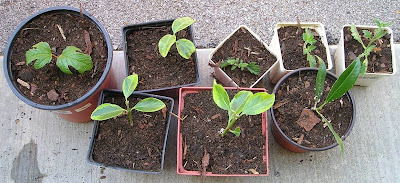Here is your dose of plant propagation for the day! Eight cuttings with roots (more or less) potted up and ready to go. I was very happy to find roots on the stem of my snowball viburnum cutting.

I added three more 'Purple Homestead' verbenas to the collection.

Here's that new snowball viburnum. This variety is sterile so vegetative propagation is the only way to propagate it. Viburnums will layer easily if you would rather propagate them through that method. Layering is much more of a "sure thing" than taking a cutting. Since the rooted plant is still attached to the mother plant it receives nourishment while it is forming roots. This new plant was made through a stem tip cutting taken in July. It may have taken 4-6 weeks for it to root; well worth the wait if you like viburnums!

Here's another English laurel to add to the other seven I have potted up. I hope one day to replace our hollies in the front garden with these 'Schip' laurels (Prunus laurocerasus). They are evergreen, have white flowers in the spring, and root fairly easily. Sounds like great plant to me!

Here are three euonymous cuttings still in the rooting medium before I potted them up. I use all sorts of regular household containers to propagate plants. I believe these are Euonymus japonicus or Golden Euonymus. These cuttings were taken from a plant that was in the shade and had lost it's variegated golden hue. I kind of like the two shades of green.

Only one of the three had real roots, the other two I decided to pot up anyway in the hopes that they would root in the potting mix.

Here is some 'Walker's Low' Catmint that I planted in the ground a few weeks ago from cuttings. It's growing strong despite a lack of rainfall. Catmint is extremely easy to take care of and propagate. Here's one quick propagating tip: pinch the terminal growth off when you start the cutting. That sends the energy into making new roots then will encourage the plant to branch, which will make a bushier plant.

This crape myrtle (Lagerstroemia indica) was started from a sucker earlier this summer. I put it in our rain garden to eventually become a background flowering tree. I'll train it to become a tree with three main stems rather than a large bush. This crape myrtle should have a reddish color on its blooms. I don't know the name of the variety but it can grow taller than 15 feet.

Labels: perennial, plant propagation, shrubs







